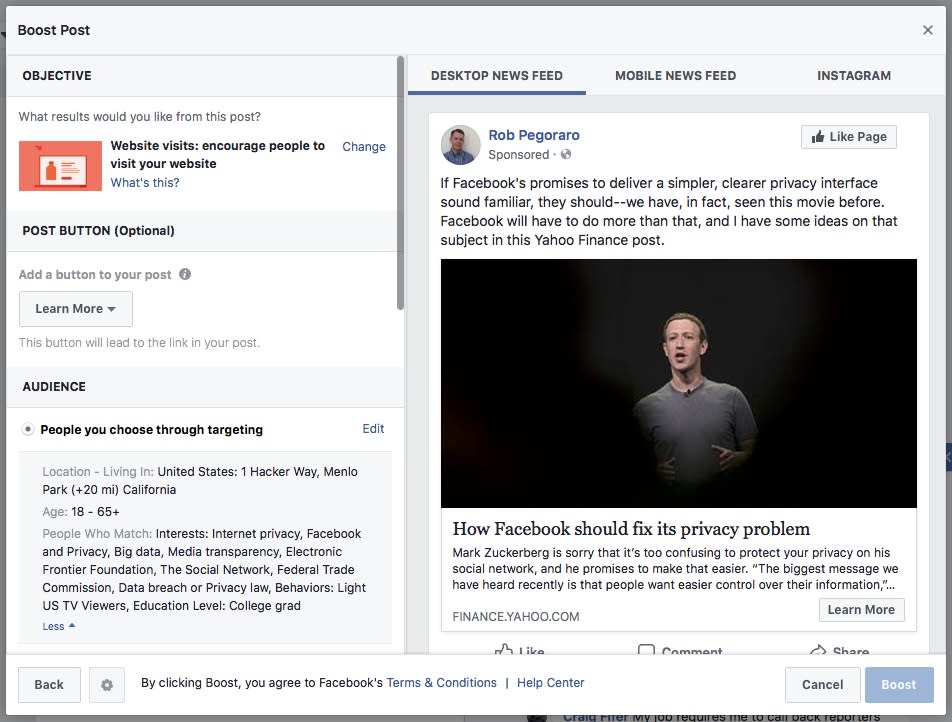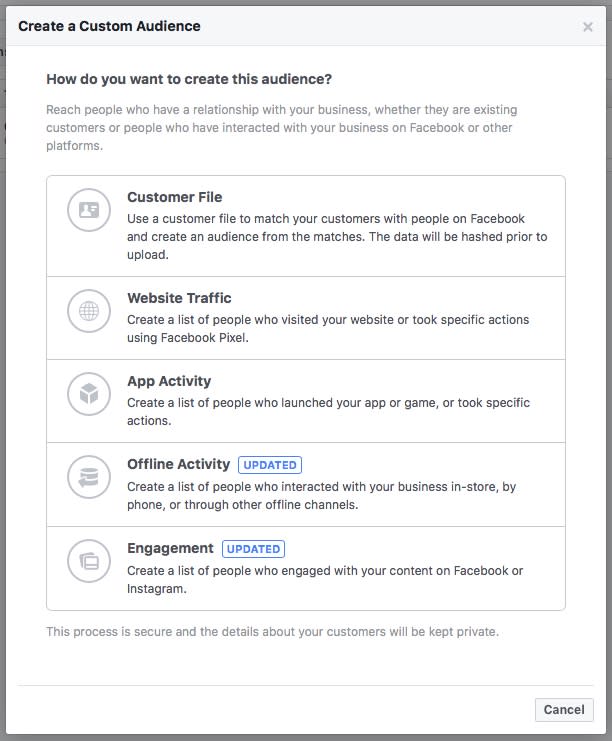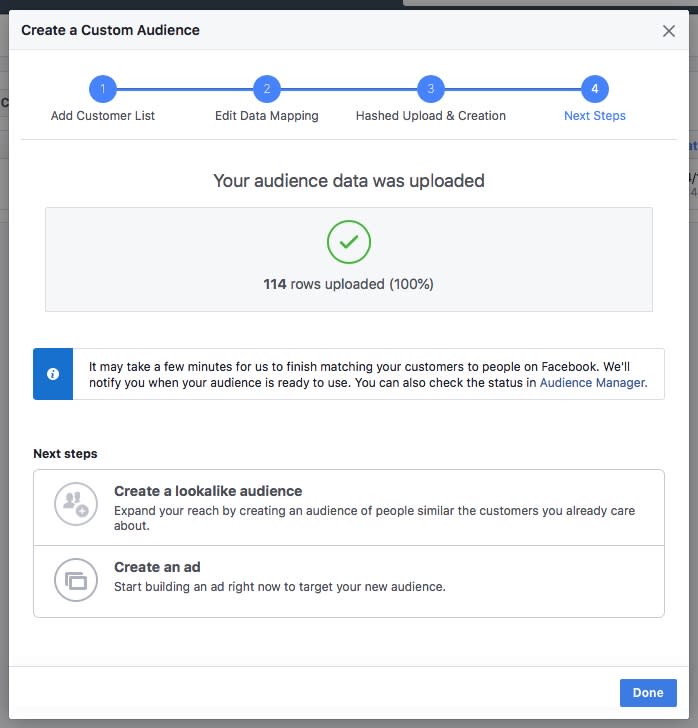How advertisers target you on Facebook

How Facebook (FB) makes money can confuse anybody. Just ask Sen. Orrin Hatch (R-Utah), who during Tuesday’s Senate interrogation of Facebook founder Mark Zuckerberg asked the 33-year-old how the social network stayed in business.
Zuckerberg’s four-word answer: “Senator, we run ads.”
But it’s how those ads come together that’s interesting, and everybody on Facebook should understand how the company can use its deep knowledge of our interests to attract advertisers anxious to aim their pitches at customers with the greatest potential returns.
Fortunately, Facebook’s ad machinery isn’t a secret; anybody who maintains a public page, myself included, can use the same basic tools to target ads at people by telling Facebook what kind of interests and demographics they want to attract — or exclude.
Address for success
Zuckerberg’s refrain “we do not sell data to advertisers” holds up on this closer inspection. Facebook has never let me see details about individual users or target them by name.
Facebook ads work the other way. You tell the social network what kind of people should see your ad, and Facebook obliges as best as it can.

It starts with a request to select the target audience’s gender (your only choices are male or female) and age range (you can set that as low as 13, Facebook’s minimum age). Then you choose a location.
Since in this test, I would be boosting a post about what Facebook should do to restore trust among its users, there was one obvious choice: Facebook’s street address of One Hacker Way, Menlo Park, CA 94025. I then included anybody within 20 miles of there.
That’s not too different from digital advertising as offered by Facebook’s competitors — including Yahoo Finance’s corporate parent Verizon (VZ).
Your interests can be interesting
But you can also target people on Facebook by their interests, something Facebook knows better than most other online companies. Type a term or phrase, and Facebook will suggest possible matches from an immense inventory of demographics, interests and behaviors.
The word “minority,” for instance, yields suggestions like “Lesser Poland,” “Los Angeles Dodgers minor league players” and “Nucleic acid double helix.” You’re more likely to be surprised by interests you can’t target — for instance, HBO’s comedy “Silicon Valley” is in Facebook’s database, but not Showtime’s drama “Billions.”

Words and phrases tied to various sorts of bigotry also appear off-limits, to judge from experimentation that hopefully doesn’t have Facebook thinking I’m a Nazi. That’s a change from what Pro Publica found last year, when its reporters could buy ads with anti-Semitic terms
In this ad test, I added such interests as “Facebook and Privacy,” the Federal Trade Commission, and “Personally identifiable information.” I tried adding “General Data Protection Regulation,” but the European Union’s sweeping privacy rule isn’t on Facebook’s list.
Facebook predicted this exercise in targeting could reach 1.7 million people — if I paid generously. Limiting my ad budget to $10 would only reach 1,000 to 3,900 people in a day.
You can also exclude demographics and interests from an ad. Last year, Pro Publica found that this system let advertisers hide housing ads from minorities, but this dialog didn’t let me add ethnic, racial or religious terms.
Custom audiences
The other way to target people by Facebook requires first finding them outside the social network. Its Custom Audiences feature lets you upload a customer list and have Facebook show your ad to those people — if your information matches what it knows about them.
The easiest way to do this is to create and upload a simple spreadsheet with people’s email addresses, phone numbers, names, birthdays and other details. You don’t, however, need their street addresses — just city, state and Zip code.
I tested this with my own info and that of three Yahoo Finance colleagues — with their permission, since Facebook’s rules require that upfront. (The minimum size for a Custom Audience upload is 100; I filled out the rest with made-up entries.)

Roughly a half hour later, Facebook had matched my database with Facebook accounts — but it didn’t tell me which ones. It then offered to expand this list’s reach by creating a “lookalike audience” of people who match the Facebook-determined traits of my custom audience.
You can also generate a Custom Audience by adding a “Facebook Pixel” to your site to track and record what visitors do there.
I didn’t actually purchase this ad after going to all this trouble, but I have bought Facebook ads before — in the spring and fall of last year, the site offered me a credit to try boosting a post on my page. The results weren’t all that impressive.
What remains a mystery
As a Facebook user, much of the social network remains a black box to me — I can only guess about some of its “People You May Know” suggestions, for instance. And while the Ad Preferences interface (facebook.com/ads/preferences) lets me see and edit what Facebook thinks fascinates me, it doesn’t tell me how it learned that.
But as an advertiser, much of this is mysterious too. I can’t tell how Facebook decides which users will be interested in a particular topic. And while I may want to avoid looking like a practitioner of surveillance capitalism, I couldn’t tell Facebook to consider only data based on people’s activity on Facebook itself.
But Facebook ads clearly work — according to the research firm eMarketer, it accounted for 19.9% of digital ad spending in 2017, second only to Google (GOOG, GOOGL). If you don’t like that, all I can suggest for now is this: try not to click on too many Facebook ads.
More from Rob:
New study finds 66% of shared links on Twitter came from bots
Sorry baseball fans: These TV networks strikeout at online streaming
Big Tech’s accountability-avoidance problem is getting worse
Email Rob at rob@robpegoraro.com; follow him on Twitter at @robpegoraro.


